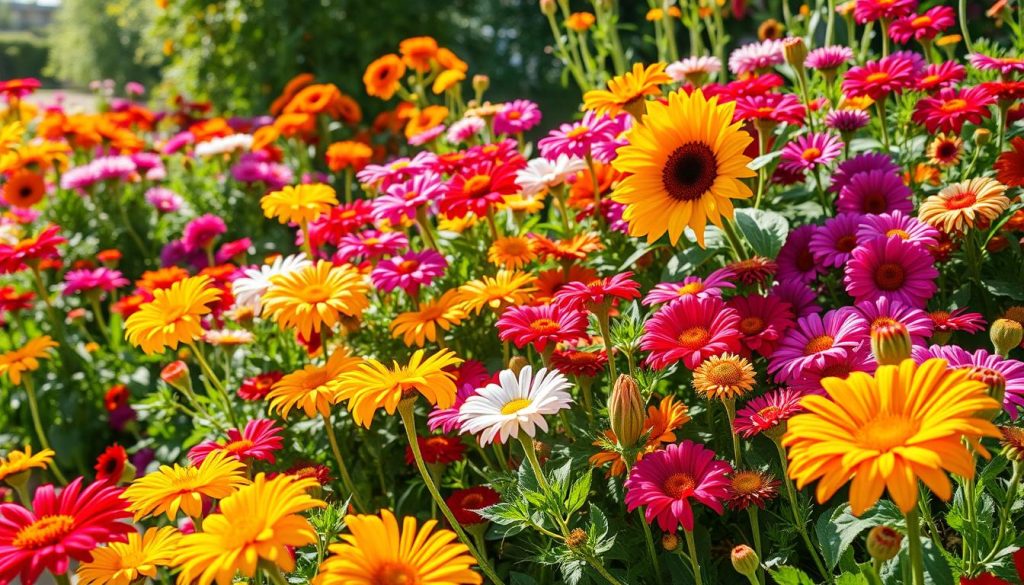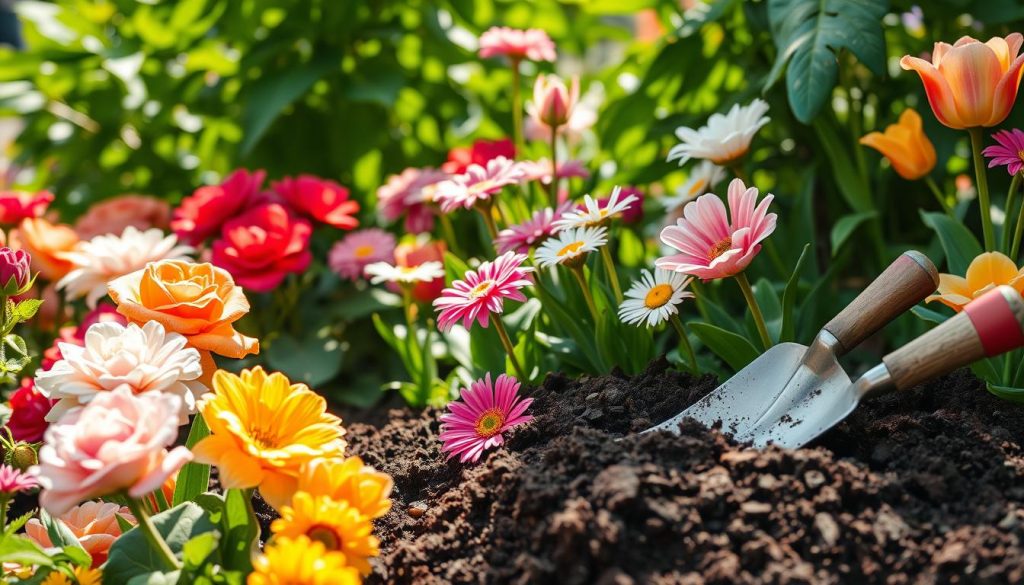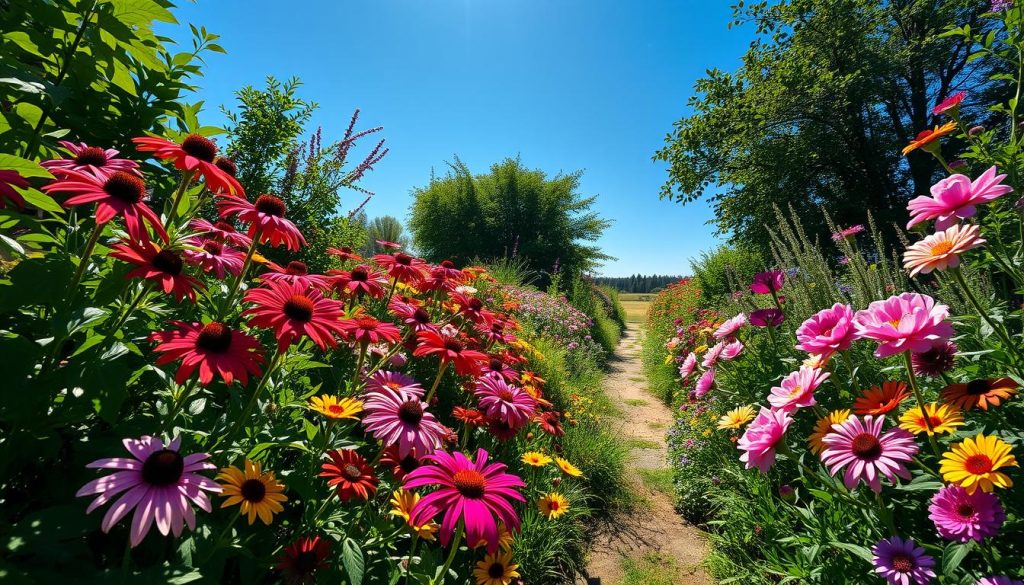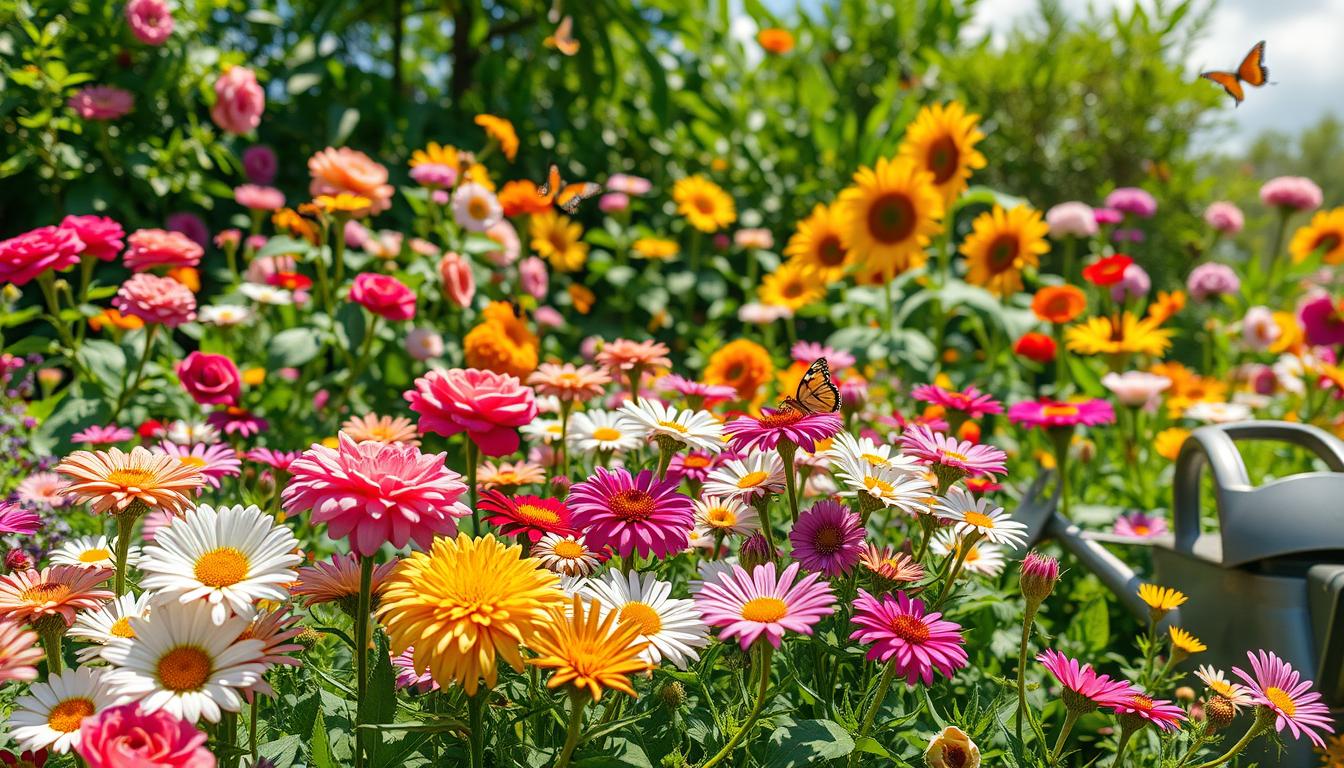Welcome to my guide on Flower Gardening. Here, I’ll share my knowledge on starting a flower garden that blooms all year. As a gardener, I’ve learned that a beautiful flower garden needs both knowledge and practice.
I’ll talk about key topics like picking the right flowers and getting your garden soil ready. It’s important to know how much sunlight and water your flowers need. This is crucial for a successful flower garden.
By following my guide, you’ll learn how to create your own vibrant flower garden. I’m excited to share my top tips with you. Let’s get started on your flower gardening journey together.
Choosing the Right Flowers for Your Garden
Starting a flower garden can seem overwhelming. There are so many flowers to choose from. It’s important to think about your climate, soil, and what you like. This will help you pick flowers that are easy to care for and will make your garden beautiful.
Beginners should look for flowers that are simple to grow. These flowers will make your garden colorful and fragrant. Here are some tips to help you choose the best flowers for your garden.
Let’s talk about annuals and perennials. Annuals live for just one year, while perennials come back every year. For beginners, marigolds, zinnias, and petunias are great annuals. Roses, lavender, and coneflowers are good perennials. Here are some benefits of each:
- Annuals: easy to grow, bloom quickly, and provide instant color
- Perennials: low maintenance, come back year after year, and attract pollinators

Native flowers are also a great choice for beginners. They fit well with your local climate and soil. Native flowers like black-eyed susans, cosmos, and sunflowers are good options. They require little care and make your garden beautiful. By choosing the right flowers, you can create a stunning garden that brings joy to your outdoor space.
Preparing Your Garden Soil
As a flower gardener, I know how vital it is to prepare your garden soil. By following key flower gardening tips, you can enhance your soil’s quality. This gives your flowers the best chance to grow well. Testing your soil’s pH level and nutrient content is a crucial step.
Here are some steps to prepare your garden soil:
- Test your soil quality to determine its pH level and nutrient content.
- Add organic matter such as compost or manure to improve soil structure and fertility.
- Understand pH levels and adjust them if necessary to create a balanced ecosystem.

By following these steps and using these flower gardening tips, you can make your soil fertile and well-draining. This will support healthy plant growth and help your flowers thrive.
| Soil Type | pH Level | Nutrient Content |
|---|---|---|
| Clay | 6.0-7.0 | High in nutrients |
| Sandy | 6.0-7.0 | Low in nutrients |
| Loamy | 6.0-7.0 | Balanced nutrient content |
Sunlight and Its Importance
When planning a perennial flower garden, think about how much sunlight your plants need. Sunlight is key for photosynthesis, and each plant has its own sunlight needs. To make your garden beautiful and thriving, pick plants that match your garden’s sunlight.
A well-thought-out perennial flower garden can really enhance your garden’s look. By choosing the right plants for your sunlight, you can create a stunning garden that blooms all season.
Assessing Sunlight Exposure
To figure out your garden’s sunlight, watch it throughout the day. Note how long it gets direct sunlight and how long it’s in partial shade. This info helps you pick the best plants for your garden.
Best Plants for Full Sun
Some plants love full sun, needing at least 6 hours of direct sunlight a day. These include:
- Roses
- Lavender
- Sunflowers
Shade-Dwelling Flowers
Other plants do well in partial shade, needing less than 6 hours of direct sunlight a day. These include:
- Impatiens
- Coleus
- Hostas

By thinking about the sunlight needs of different plants, you can create a garden with a mix of beautiful flowers. Choose plants that fit your garden’s sunlight, and feel free to try out different ideas to find the perfect mix for your space.
Watering Techniques That Work
Watering is key in flower garden design. It can make your garden beautiful and healthy. As someone who loves organic gardening, I’ve found the right watering methods save water and keep gardens thriving.
To have a beautiful flower garden, knowing how much water your flowers need is important. Too much water can harm them, while too little can make them weak. Aim to give 1-2 inches of water per week, from rain or irrigation.
How Much Water Do Flowers Need?
- Check the soil moisture by inserting your finger into the soil up to the knuckle
- Water deeply but infrequently to encourage deep root growth
- Avoid frequent shallow watering, which can lead to weak and shallow roots

Best Times to Water
Watering at the right time helps prevent water loss and diseases. Water in the early morning or late evening when the sun is not strong.
Using Mulch for Moisture Retention
Mulch keeps soil moist, cutting down on watering needs. Organic mulch like wood chips or straw also keeps soil temperature right and stops weeds. It’s perfect for organic gardening.
Fertilizing Your Flowers
As I care for my organic flower garden, I’ve learned how vital fertilizing is. It helps my flowers grow strong and bloom beautifully. Choosing the right fertilizer can be tough, with so many options out there.
In organic gardening, knowing the difference between organic and chemical fertilizers is key. Organic fertilizers, like compost, give nutrients slowly and gently. Chemical fertilizers, on the other hand, give a quick boost but can harm the soil and environment.
Types of Fertilizers
- Organic fertilizers: compost, manure, and green sand
- Chemical fertilizers: synthetic fertilizers, such as ammonium nitrate and urea
Knowing when to fertilize is also important. Fertilize during the growing season, usually spring and summer. Too much fertilizer can hurt your plants, so always follow the right amounts.
Signs of Nutrient Deficiency
Spotting nutrient deficiencies is crucial for your flowers’ health. Look for yellow leaves, slow growth, and poor blooms. Catching these signs early lets you give your flowers the nutrients they need to thrive.
Pest Management Strategies
As a flower garden lover, I know how vital pest management is. Keeping your garden healthy and vibrant depends on it. Seasonal gardening helps prevent pests from taking over.
Identifying pests like aphids, whiteflies, and spider mites is key. Using natural methods, like introducing beneficial insects and neem oil, can keep pests in check.
Identifying Common Garden Pests
- Aphids: small, soft-bodied insects that feed on plant sap
- Whiteflies: tiny, winged insects that feed on plant sap
- Spider mites: small, spider-like insects that feed on plant sap
Natural Pest Control Methods
Natural pest control is crucial in seasonal gardening. Some effective methods include:
- Introducing beneficial insects, such as ladybugs and lacewings
- Using neem oil to control pest populations
- Practicing good garden hygiene, including removing weeds and debris
When to Use Chemical Treatments
Chemical treatments might be needed sometimes. But, use them wisely. They can harm good insects and the environment.
| Pest | Natural Control Method | Chemical Treatment |
|---|---|---|
| Aphids | Introduce beneficial insects, such as ladybugs | Use insecticidal soap or neem oil |
| Whiteflies | Use yellow sticky traps or introduce beneficial insects | Use insecticidal soap or pyrethrin |
| Spider mites | Use neem oil or introduce beneficial insects | Use insecticidal soap or miticides |
Pruning and Deadheading Flowers
Starting with flower gardening? Pruning and deadheading are key. Pruning keeps plants in shape. Deadheading makes them bloom more and stops seeds.
These practices help your garden grow well. They make your flowers bloom more and look better. They’re important for any gardener, new or experienced.
Benefits of Pruning
Pruning has many benefits:
- It improves air flow, which fights off diseases.
- It lets more sunlight in, helping plants grow strong.
- It makes plants bloom more, as it encourages new flowers.
How to Properly Deadhead
Deadheading is easy. It means cutting off old flowers to make new ones grow. Here’s how to do it right:
- Find old flowers and cut them off at the base.
- Make clean cuts just above a leaf node to help new growth.
- Throw away the old flowers to stop seed production and encourage new blooms.
Timing for Best Results
When to prune and deadhead depends on the plant. Prune in the early growing season. Deadhead all season long. By following these tips, your garden will bloom beautifully all year.
| Plant Type | Pruning Time | Deadheading Time |
|---|---|---|
| Annuals | Early growing season | Throughout blooming period |
| Perennials | After blooming | After blooming |
Seasonal Flower Gardening Tips
Starting with flower gardening is exciting. Knowing about seasonal gardening is key. Each season offers a chance to make your garden beautiful and lively. Here are some tips to get you started.
Spring Planting Essentials
In spring, plant cool-weather flowers like tulips and daffodils. Mix these with greenery like eucalyptus or ferns for a great look.
Summer Care Techniques
In summer, keep your flowers watered and sunny. Try combining sunflowers with baby’s breath and ribbon for a beautiful arrangement.
Preparing for Fall and Winter
For fall, start getting your garden ready for winter. Plant flowers like pansies and violas. For winter arrangements, use evergreen branches and pinecones for texture.
Follow these tips for a garden that blooms all year. Always think about what your flowers need. And don’t forget to have fun with different flower arrangements.
| Season | Flowers to Plant | Flower Arrangement Ideas |
|---|---|---|
| Spring | Tulips, Daffodils | Tulips with eucalyptus, Daffodils with ferns |
| Summer | Sunflowers, Baby’s Breath | Sunflowers with baby’s breath and ribbon |
| Fall and Winter | Pansies, Violas | Evergreen branches with pinecones and flowers |
Creating Beautiful Arrangements
To make stunning flower arrangements, knowing flower arrangement ideas and advanced gardening techniques is key. This knowledge helps you pick the right flowers, foliage, and fillers. It ensures your arrangement is balanced and looks good together.
Flower Arrangement Basics
Think about the color, texture, and shape of your flowers and foliage. Mixing different flower arrangement ideas can make your arrangement unique and beautiful. Techniques like pruning and deadheading can also enhance your display.
Using Foliage and Fillers
Foliage and fillers add depth and texture to your arrangement. Try using different foliage like eucalyptus or ferns, and fillers like baby’s breath or queen anne’s lace. This will help you create a beautiful and unique arrangement.
Tips for Indoor Displays
For a stunning indoor display, consider the room’s lighting and temperature. Most flowers like bright, indirect light and temperatures between 65-75°F. By following these tips and using your flower arrangement and gardening knowledge, you can make a beautiful arrangement that lasts.
Continuous Learning and Improvement
As a passionate flower gardener, I’ve found that growth and discovery never stop. The world of horticulture is always changing, with new techniques and plants coming out all the time. To be the best, I’ve learned that never stopping learning and improving is key.
Garden Clubs and Workshops
Being part of a local garden club or attending workshops has been a big help. These groups offer a lot of knowledge, shared experiences, and a chance to meet other gardeners. I’ve picked up a lot from experts and hobbyists alike, and the friendship has kept me inspired.
Online Resources and Forums
Online learning has also been a big change for me. With blogs, YouTube, and forums, I can learn and get support anytime. I stay current with new gardening techniques and connect with gardeners worldwide.
Keeping a Gardening Journal
My gardening journal has been a huge help. It lets me track my progress, see patterns, and make better garden choices. This journal is my go-to for learning from my experiences and getting better at gardening.

